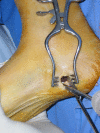Chronic plantar fasciitis: plantar fasciotomy versus gastrocnemius recession
- PMID: 23959221
- PMCID: PMC3764291
- DOI: 10.1007/s00264-013-2022-2
Chronic plantar fasciitis: plantar fasciotomy versus gastrocnemius recession
Abstract
Purpose: The purpose of this study was to compare results of partial proximal fasciotomy (PPF) with proximal medial gastrocnemius release (PMGR) in the treatment of chronic plantar fasciitis (CPF).
Method: This retrospective study compares 30 patients with CPF that underwent PPF with 30 that underwent isolated PMGR. Both groups were matched in terms of previous treatments and time from onset of symptoms to surgery. Different standardised evaluation scales (VAS, Likert, AOFASh) were used to evaluate results.
Results: Plantar fasciotomy had satisfactory results in just 60 % of patients, with an average ten weeks needed to resume work and sports. Patient satisfaction in the PMGR group reached 95 %, being back to work and sports at three weeks on average. Functional and pain scores were considerably better for PMGR and fewer complications registered.
Conclusion: In our series, isolated PMGR is a simple and reliable procedure to treat patients with CPF. It provides far better results than conventional fasciotomy with less morbidity and better patient satisfaction, and thus has become our surgical procedure of choice in recalcitrant CPF.
Figures





References
-
- Riddle DL, Schappert SM. Volume of ambulatory care visits and patterns of care for patients diagnosed with plantar fasciitis: a national study of medical doctors. Foot Ankle Int. 2004;25:303–310. - PubMed
-
- Aronow MS, Diaz-Doran V, Sullivan RJ, Adams DJ. The effect of triceps surae contracture force on plantar foot pressure distribution. Foot Ankle Int. 2006;27:43–52. - PubMed
-
- Silfverskiöld N. Reduction of the uncrossed two-joint muscles of the leg to one joint muscles in spastic conditions. Acta Chir Scand. 1923;56:315–330.
Publication types
MeSH terms
LinkOut - more resources
Full Text Sources
Other Literature Sources

